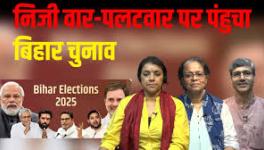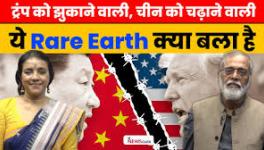Relook at a Book: Attia Hosain’s Classic Novel Provides Different Lens to Look at Partition
First edition by Chatto and Windus in Great Britain in 1961, Virago edition with Anita Desai’s new introduction in 1988.
When I was working on my M. Phil. degree dissertation in JNU, which focussed on the partition of India and Punjabi literature, I had a list of creative writings on partition in various languages. I wanted to refer to those in my overall survey of the partition literature. I could get some books from my list, but not all, as one could expect. But one book which I really missed those days and always kept on looking for was Attia Hosain's English novel Sunlight on a Broken Column. And after a gap of many decades, I found it in a library in Trinidad, as I found many other books – like C L R James's classic The Black Jacobins.
Sunlight on a Broken Column was published for the first time in 1961 by Chatto and Windus in Great Britain. Later in 1988, Virago Press published it with a new introduction. Then, Penguin books published it in 1992 with an even newer introduction by another eminent Indian novelist, Anita Desai.
Attia Hosain was born in 1913 in a feudal Muslim family in Lucknow; got liberal education and was the first woman to graduate from amongst the 'Taluqdari' families. Her parents had close relations with the Nehru clan. She was influenced by the nationalist movement and progressive writers’ movement in the 1930s. She became a journalist, broadcaster and writer of fiction. She went to England in 1947 with her husband and two children and wrote a short story collection in 1953 titled Phoenix Fled and her only novel, which later became a classic, in 1961.
The title of the novel is taken from T.S. Eliot's poem ‘The Hollow Men', reading as:
There, the eyes are
Sunlight on a Broken Column......
Partly, this is an autobiographical novel as the events occurring in protagonist Laila's life are close to the writer's own life. Laila, the narrator of the novel, is a granddaughter of Baba Jan-Syed Mohammed Hasan; she was orphaned after the death of both her parents. She is being taken care of by her grandfather and later, after his death, by her uncle Hamid and aunts. This is a typical feudal Muslim family but enlightened and liberal in a limited sense. Girls are allowed to have higher education and Laila avails that, but they are not allowed to choose their own husbands and their family standards and status must be followed. All other members of the family follow suit, but not Laila. She chooses her own husband Ameer, though from a feudal background, but not of their family's economic standards. She rebels and marries him against the wishes of the older members of the family, as the younger ones like Kemal and Saleem, and his cousins support her. Her husband leaves his teaching job a few years later and joins the army – partly due to the complexes induced in him by Laila’s family. He dies during World War II, leaving a baby girl behind.
The novel, divided into four parts and 61 chapters, does not depict partition directly, but focuses on its impact on Muslim families – particularly feudal ones. This is the class from which protagonists of a separate nation for Muslims came. But this class itself was divided into 'for' and 'against' partition, which resulted in families splitting. While some chose Pakistan as their destiny, some stayed back in India near their roots.
In the novel, uncle Hamid dies just before this dilemma arises, but the surviving family meets at the instance of Kemal, a senior officer now in the Indian Government, and the elder son of Hamid. His younger brother Saleem, with his wife Nadira, decides to go to Pakistan. In the last part of the novel, there are a few poignant scenes. Laila has returned to India after a few years. Her husband is now dead and she has a daughter. Sita Aggarwal, her childhood friend, who loved Kemal in England, but did not marry him by rebelling against social norms, has come to share her grief. Abida, her aunt, who loved her a lot and Laila loved her equally, has just died. Abida, herself an enlightened one, had introduced Laila to Ghalib and other great writers. But she could not reconcile Laila's marriage to Ameer against family wishes. The after-effects of partition now can be felt. Saleem has to report to the police every day for visiting his 'own' home and family in Lucknow and Hasanpur, the family’s ancestral house. The novel ends there on a sad note, as Laila is waiting for his distant nationalist cousin Asad to reach and see her.
There are many more events in the novel – the oppression of Nandi or Saliman-like poor characters, who slog throughout their lives to serve their feudal master and for whom only Laila had any sympathy.
The novel, of course, is strong in its aesthetic appeal; but it raises many questions. It also helps understand the atmosphere of pre-partition India and the reasons, though completely irrational, for the inevitable partition. Now, we know of many Pakistani friends’ nostalgia for pre-partition India, and similar attachment to Pakistani regions and people experienced in post-partition India. The elite of both the communities and also common working people, who had nothing to do with politics and religion, had excellent relations with each other. But educated middle classes from upper strata in both communities, through their imagined history, had created deep-rooted biases against each other. Both had a sense of superiority over the other. While one side thought of the others as 'malechh (the impious)’, the others thought of the former as 'banias (the cowardly and petty dishonest shopkeepers)’. Partition was becoming inevitable under these socio-cultural conditions and socialist leaders of Congress like Jawaharlal Nehru had no real assurance to offer to the Muslim community – of 'true secularism' in the 'nationalist' agenda of the Congress party. The Muslim community definitely tilted towards the Muslim League in large numbers in absence of such an assurance.
The forced division of Punjab and Bengal on communal lines resulted in the mass migration of minority communities and also in mass massacres and other unthinkable crimes. The Kashmir problem got embedded into the destinies of the two countries permanently and there have been four terrible wars between India and Pakistan. Militaries of both countries treat each other as the ultimate enemies. Partition, thus, turned out to be a festering wound. In absence of a sizeable minority population, Jinnah's elitist liberal Pakistan gave way to religious fundamentalist Pakistan dictated by jehadi Mullahs, supported/prompted by the Saudi Arabia variety of Islam. If Pakistan is not able to fight the cancerous growth of religious fundamentalism, not only Pakistan's liberal educated elite – represented in Attia Hosain's characters – will be wiped out, but India itself would not escape this cancer's weeds spilling over to India leading to equally cancerous Hindu fundamentalist rise in reaction. As a result, the whole pre-partition India, now divided into three nations, will suffer together – as it fought for its freedom from British colonialism together. Some cultures are so complex that these cannot be ripped apart even by way of dividing the territories. They remain bound like the child’s bond with the mother's womb through its umbilical cord.
But what can nations do in such situations? They definitely can resolve these issues, but only by looking at things in a dispassionate, objective, and rational manner. Even if the partition of India was irrational, it cannot be withdrawn now, nor can Bangladesh go back to the fold of Pakistan again. So, the first rational act on the part of India and Pakistan is to accept each other's existence in their present form, admitting the unresolved issues like Kashmir. Both countries also have to admit that the destinies of both countries, despite political-geographical divisions, are somehow bound with each other. The interests of a large majority of people in both countries lie in peaceful and possibly fraternal existence between the two nations. This includes the enlightened ruling classes on both sides, but not those sections of ruling classes, which have vested interests in furthering the spread of religious fundamentalism everywhere. And for this peaceful existence, both countries need to have democratic polity surviving and strengthening in both countries.
Would this great ‘tragedy humane’ in Balzac’s words ever end and progressive forces in Pakistan and India would see the dawn of 'Woh Subah…' conceived by its poets? We can hope that rather than sunlight, there will be 'moonlight' on the banks of rivers Gomati and Ravi. Romantic lovers like Laila and Ameer might be able to meet in this moonlight without fearing the feudal and fundamental forces lurking in the shadows...
Attiya Hosain, ‘Sunlight on a Broken Column’, Penguin India, 1992 ed., Pages 319, Rs 125
The author is Former Dean, Faculty of Languages, Panjab University Chandigarh and Honorary Advisor, Bhagat Singh Archives and Resource Centre.
Get the latest reports & analysis with people's perspective on Protests, movements & deep analytical videos, discussions of the current affairs in your Telegram app. Subscribe to NewsClick's Telegram channel & get Real-Time updates on stories, as they get published on our website.














